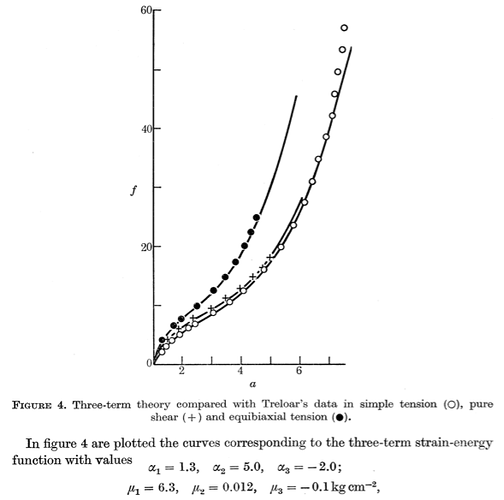It looks like both are the same model with different constants, the issue is that these models are approximations to compressible behaviour but have to be considered almost incompressible.Ogden Hyperelastic Model for Nonlinear Finite Element Analysis | by WELSIM - Engineering Simulation Software | Medium
Ogden conditions look mandatory for strictly incompressible models but maybe can be relaxed for compressible materials (however an approximation to almost incompressible materials).
Yes. In fact, this post was motivated by a high value of the Jacobian. I guess I need to track it to see how far I can go. I have just realize this verification file has the same constants I was using so it should be fast to extract the values a plot.
but did you take into account this limitation?

CCX finite element formulation cannot solve incompressible materials so there is a limit to the values Di 's can accept.
Yes. I also discovered (not really me, Victor and Calc_em ) that going too far with D1 and D2 can trigger ccx to automatically consider a minimum value of compressibility, so I have to set up as low as possible but carefully.
EDITED: Much better this time. ![]() . I think Abaqus struggles with incompressibility too up to a certain point because the verification doesn’t impose the same strain ratio to all the stress states. (They know biaxial is more fragile. I think I understan better the picture. ) Let’s see how it ends up.
. I think Abaqus struggles with incompressibility too up to a certain point because the verification doesn’t impose the same strain ratio to all the stress states. (They know biaxial is more fragile. I think I understan better the picture. ) Let’s see how it ends up.
Ogden’s original formulation is not the same as Abaqus/CCX so if I do the conversion with this example I get mu_Og_1=160, alpha1=2, mu_Og_2=-40, alpha2=-2, that fits original Ogden’s criteria, using this formula

my remark was done before I checked that there are 2 different formulations.
Nice. I think this check could be incorporated into ccx and send a warning in case it’s not fulfilled.
Ogden is not responding as expected. Those parameters do not fit the Treloar Experimental data as Arruda did not even close.
There is a very big difference and I’m considering various options.
-Ogden N2 is unable to capture that behavior and that is not a good verification example.
-I’m not reading those parameters properly (I don’t understand why manual says units are not important just for that model¿?¿?). I have also considered they are expressed in the same units as Treloar results (Kgf/cm2) but …no.
-There is some issue with the Ogden material model as Abaqus verification file says there is good agreement.
Has someone else try those coefficients?. They don’t fit the curves to me.
I have work on Neo Hook and Mooney Rivlin too. Waiting for response but at first sight seems there is an excellent agreement.
Ogden himself in his original paper fitted Treloar experimental data (WARNING: coefficients are those of Ogden’s original formulation, not the one in CCX/ABQ)
I haven’t checked if data in Abaqus manual is equivalent to that in Ogden1972 but looks like it is not…
I have checked the conversion with CCX formulation from data in the paper and get same results using mu1=8.8277 [MPa] , alpha1=-4.2883, D1=0.001 so looks OK (original data used original Ogden’s model with mu1=-4.1171, alpha1=-4.2883, incompressible). I haven’t checked yet biaxial, planar, volumetric…




